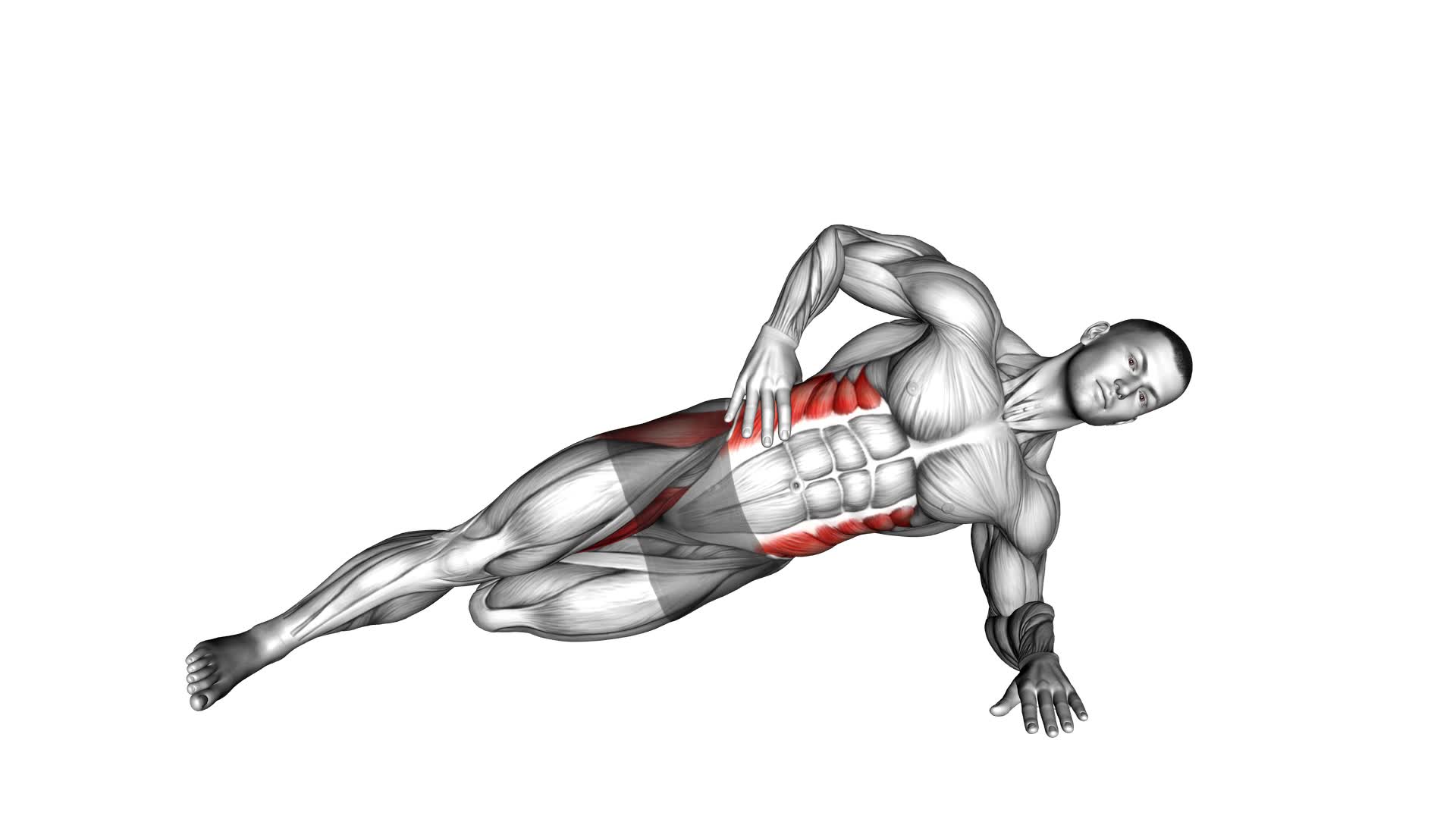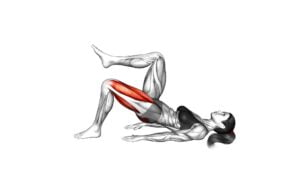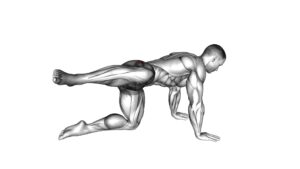Side Bridge With Bent Leg (Male) – Video Exercise Guide & Tips

Are you looking to strengthen your core and improve your balance? Check out the Side Bridge With Bent Leg exercise!
Watch This Exercise Video
In this video exercise guide, we'll show you the proper form and technique to get the most out of this challenging move. Whether you're a beginner or have limited mobility, we've got modifications for you.
Plus, we'll share tips on how to progress and avoid common mistakes. Get ready to add this exercise to your fitness routine and level up your core strength!
Key Takeaways
- Side bridge with bent leg increases core strength and improves stability.
- It strengthens abdominal muscles and enhances overall fitness and performance.
- Side bridge with bent leg improves balance and coordination.
- Proper form and technique, as well as modifications and progressions, are important for maximizing the benefits of side bridge with bent leg exercise.
Benefits of the Side Bridge With Bent Leg
You can experience several benefits from incorporating the side bridge with a bent leg into your workout routine. This exercise is a great way to increase your core strength and improve your stability. By engaging your core muscles, such as the obliques and transversus abdominis, the side bridge with a bent leg helps to strengthen your abdominal muscles. This increased core strength can have a positive impact on your overall fitness and performance in other exercises and activities.
In addition to core strength, the side bridge with a bent leg also improves stability. By balancing on one side of your body, you're challenging your muscles to work together to maintain stability and control. This can help to improve your balance and coordination, making you more efficient and effective in your movements.
Incorporating the side bridge with a bent leg into your workout routine can be done in various ways. You can start by holding the position for a few seconds and gradually increase the duration as you get stronger. You can also add variations, such as lifting the top leg or incorporating a side plank with a bent leg, to further challenge your muscles.
Proper Form and Technique for the Exercise
To perform the Side Bridge With Bent Leg exercise properly, there are a few key form tips to keep in mind. First, make sure your body forms a straight line from your head to your heels. Keep your core engaged and avoid sagging or lifting your hips.
Lastly, maintain a slight bend in your bottom leg to provide stability and support throughout the exercise. Avoid common technique mistakes such as lifting your top leg too high or allowing your shoulders to hunch.
Key Form Tips
Maintain a straight line from your head to your feet while performing the Side Bridge With Bent Leg exercise. Proper alignment is crucial for this exercise to ensure maximum effectiveness and minimize the risk of injury.
Start by lying on your side with your elbow directly under your shoulder and your legs bent at a 90-degree angle. Engage your core and lift your hips off the ground, keeping your body in a straight line.
Focus on activating your oblique muscles on the side of your body facing the ground. Keep your neck relaxed and avoid letting your hips sag or rotate.
Common Technique Mistakes
Avoiding common technique mistakes is essential for mastering the Side Bridge With Bent Leg exercise and maximizing its effectiveness.
To ensure proper form and technique, here are some common mistakes to avoid and some helpful tips.
- Firstly, make sure to keep your body in a straight line from head to toe, avoiding any sagging or arching of the lower back. Engage your core muscles to maintain stability throughout the exercise.
- Another common mistake is lifting the hips too high or too low. Find a neutral position where your body is aligned and parallel to the ground.
- Lastly, avoid rushing through the exercise and focus on controlled movements. This will help engage the targeted muscles effectively.
Modifications for Beginners or Those With Limited Mobility
How can you adapt the Side Bridge With Bent Leg exercise if you're a beginner or have limited mobility? Here are three modifications that can help you get started or accommodate your physical limitations:
- Reduce the intensity: If you're a beginner or have limited mobility, you can start by performing the side bridge with your knees bent instead of straightening your legs. This modification reduces the strain on your core and makes the exercise more manageable.
- Use a prop for support: If you have difficulty maintaining balance or stability during the side bridge, you can use a prop for support. Place a yoga block or a rolled-up towel underneath your bottom hand to provide extra support and make the exercise easier to perform.
- Focus on smaller movements: If you have limited mobility or are recovering from an injury, you can start by focusing on smaller movements. Instead of lifting your hips high off the ground, aim to lift them just a few inches. This will still engage your obliques and core muscles while accommodating your physical limitations.
How to Progress and Challenge Yourself With This Exercise
To progress and challenge yourself with the Side Bridge With Bent Leg exercise, you can increase the amount of time you hold the position or the number of reps you perform.
Another way to intensify the exercise is by adding weight, such as a dumbbell or kettlebell, to your free hand.
Increasing Time or Reps
Challenge yourself and progress in the side bridge with bent leg exercise by gradually increasing the amount of time or number of reps you perform. Here are three ways to do it:
- Increase Time: Start by holding the side bridge position for 10 seconds and gradually work your way up to 30 seconds or longer. This will help build endurance and strengthen your core muscles.
- Add Reps: Begin with 5 reps on each side and aim to gradually increase the number of reps you can do. Start by adding one rep at a time until you can comfortably perform 10 reps on each side.
- Try Advanced Variations: Once you're comfortable with the basic side bridge with bent leg exercise, you can challenge yourself by trying more advanced variations. These can include lifting your top leg or arm, adding a resistance band, or performing the exercise on an unstable surface like a Bosu ball.
Remember to listen to your body and progress at your own pace. Consistency and gradual increases in difficulty will help you get the most out of this exercise.
Adding Weight for Intensity?
As you progress in the side bridge with bent leg exercise, you can further challenge yourself by incorporating additional weight for increased intensity. Adding resistance can help to target and strengthen your core muscles even more. You can do this by holding a dumbbell or kettlebell on the side of your body while performing the exercise. Start with a lighter weight and gradually increase as you become stronger and more comfortable with the movement.
It's important to maintain proper form and control throughout the exercise, so make sure the weight you choose allows you to do so. If you don't have access to weights, you can also try alternative exercises such as side plank variations or using resistance bands to add intensity to your workout.
Now let's explore some common mistakes to avoid during the side bridge with bent leg.
Common Mistakes to Avoid During the Side Bridge With Bent Leg
To ensure proper form and maximize the effectiveness of the side bridge with bent leg exercise, you should avoid these common mistakes:
- Raising your hips too high: One common mistake is lifting your hips too high during the side bridge with a bent leg. This not only reduces the engagement of your core muscles but also puts unnecessary strain on your lower back. To avoid this, focus on maintaining a straight line from your head to your heels throughout the exercise.
- Allowing your hips to sag: On the opposite end of the spectrum, allowing your hips to sag is another mistake to avoid. This not only takes the tension off your core muscles but also increases the risk of injury. Keep your core engaged and your body in a straight line to maximize the benefits of this exercise.
- Neglecting proper breathing technique: Breathing is often overlooked during exercises, but it plays a crucial role in maintaining proper form and maximizing the effectiveness of the side bridge with a bent leg. Remember to inhale deeply through your nose and exhale fully through your mouth, keeping your core engaged throughout the movement.
Tips for Incorporating This Exercise Into Your Fitness Routine
To effectively incorporate the side bridge with bent leg exercise into your fitness routine, you can follow these tips.
First, consider incorporating variations of the exercise to keep your routine challenging and engaging. You can try performing the side bridge with a straight leg or by adding a leg lift for an extra challenge. These variations target different muscle groups and can help you avoid plateaus in your progress.
Another tip is to include stability training exercises in your routine. The side bridge with bent leg is a great stability exercise that strengthens your core and improves your balance. By adding stability training to your workouts, you can enhance your overall strength and reduce the risk of injuries.
When incorporating the side bridge with bent leg into your fitness routine, it's important to start with proper form. Make sure to keep your body aligned from head to toe and engage your core muscles throughout the exercise. Also, remember to breathe steadily and avoid holding your breath.
Lastly, be consistent with your practice. Aim to perform the side bridge with bent leg exercise at least two to three times a week to see noticeable improvements in your core strength and stability. By following these tips, you can effectively incorporate this exercise into your fitness routine and reap the benefits of stability training.
Frequently Asked Questions
Can the Side Bridge With Bent Leg Help With Back Pain?
Yes, the side bridge with bent leg can help with back pain. By engaging your core and stabilizing your spine, this exercise can strengthen your back muscles and improve your posture.
It's particularly beneficial for beginners as it provides a modified version of the traditional side bridge. To maximize the effectiveness, make sure to maintain proper form and avoid any excessive strain on your back.
Is It Necessary to Warm up Before Performing the Side Bridge With Bent Leg?
Before performing the side bridge with bent leg, it's important to warm up. Warming up helps increase blood flow, loosen muscles, and reduce the risk of injury.
Proper form is crucial in this exercise to target the right muscles and avoid strain. Beginners can modify the side bridge with bent leg by starting with a shorter hold time and gradually increasing it.
Remember to engage your core and maintain a straight line from head to toe for maximum effectiveness.
Can the Side Bridge With Bent Leg Help Improve Core Strength?
The side bridge with bent leg is a great exercise for improving core strength. By incorporating this move into your workout routine, you can experience a variety of benefits.
It targets the muscles in your abs, obliques, and lower back, helping to strengthen and tone them. Plus, it can improve stability and balance.
To make the exercise more challenging, you can try different variations or modifications such as adding a leg lift or using a stability ball.
What Muscles Are Targeted During the Side Bridge With Bent Leg Exercise?
During the side bridge with bent leg exercise, several muscles are targeted. Your obliques, which are the muscles on the sides of your abdomen, are heavily engaged as they work to stabilize your body. Additionally, the muscles in your hips, glutes, and shoulders are activated to maintain proper alignment.
How Often Should the Side Bridge With Bent Leg Be Performed for Optimal Results?
To achieve optimal results with the side bridge with bent leg exercise, it's important to perform it regularly. By incorporating different side bridge variations and progressing in the exercise, you can continuously challenge and strengthen your core muscles.
Consistency is key, so aim to do the side bridge with bent leg a few times a week. This will help you build endurance and improve stability in your core, ultimately leading to better overall fitness.
Conclusion
Incorporating the side bridge with a bent leg into your fitness routine can provide numerous benefits. This exercise targets your core muscles, improves stability, and enhances overall strength.
By following proper form and technique, you can maximize the effectiveness of this exercise. If you're a beginner or have limited mobility, modifications can be made to suit your needs.
As you progress, challenge yourself by increasing the duration or adding resistance. Avoid common mistakes and enjoy the benefits of this versatile exercise.

Author
Years ago, the spark of my life’s passion ignited in my mind the moment I stepped into the local gym for the first time. The inaugural bead of perspiration, the initial endeavor, the very first surge of endorphins, and a sense of pride that washed over me post-workout marked the beginning of my deep-seated interest in strength sports, fitness, and sports nutrition. This very curiosity blossomed rapidly into a profound fascination, propelling me to earn a Master’s degree in Physical Education from the Academy of Physical Education in Krakow, followed by a Sports Manager diploma from the Jagiellonian University. My journey of growth led me to gain more specialized qualifications, such as being a certified personal trainer with a focus on sports dietetics, a lifeguard, and an instructor for wellness and corrective gymnastics. Theoretical knowledge paired seamlessly with practical experience, reinforcing my belief that the transformation of individuals under my guidance was also a reflection of my personal growth. This belief holds true even today. Each day, I strive to push the boundaries and explore new realms. These realms gently elevate me to greater heights. The unique combination of passion for my field and the continuous quest for growth fuels my drive to break new ground.



